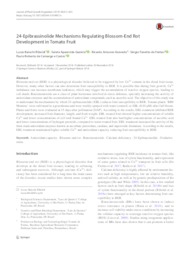24-Epibrassinolide mechanisms regulating blossom-end rot development in tomato fruit.
24-Epibrassinolide mechanisms regulating blossom-end rot development in tomato fruit.
Author(s): RIBOLDI, L. B.; GAZIOLA, S. A.; AZEVEDO, R. A.; FREITAS, S. T. de; CASTRO, P. R. de C. e
Summary: Blossom-end rot (BER) is a physiological disorder believed to be triggered by low Ca2+ content in the distal fruit tissue. However, many other factors can also determine fruit susceptibility to BER. It is possible that during fruit growth, Ca2+ imbalance can increase membrane leakiness, which may trigger the accumulation of reactive oxygen species, leading to cell death. Brassinosteroids are a class of plant hormones involved in stress defenses, specially increasing the activity of antioxidant enzymes and the accumulation of antioxidant compounds, such as ascorbic acid. The objective of this study was to understand the mechanisms by which 24-epibrassinolide (EBL) reduces fruit susceptibility to BER. Tomato plants ?BRS Montese? were cultivated in a greenhouse and were weekly sprayed with water (control) or EBL (0.01 ?M) after full bloom. Plants and fruits were evaluated at 15 days after pollination (DAP). According to the results, EBL treatment inhibited BER development, increased fruit diameter, length, and fresh weight. EBL-treated fruit showed higher concentrations of soluble Ca2+ and lower concentrations of cell wall-bound Ca2+. EBL-treated fruit also had higher concentrations of ascorbic acid and lower concentrations of hydrogen peroxide, compared to water-treated fruit. EBL treatment increased the activity of the three main antioxidant enzymes known as ascorbate peroxidase, catalase, and superoxide dismutase. According to the results, EBL treatment maintained higher soluble Ca2+ and antioxidant capacity, reducing fruit susceptibility to BER.
Publication year: 2019
Types of publication: Journal article
Unit: Embrapa Semi-arid Region
Observation
Some of Embrapa's publications are published as ePub files. To read them, use or download one of the following free software options to your computer or mobile device. Android: Google Play Books; IOS: iBooks; Windows and Linux: Calibre.
Access other publications
Access the Agricultural Research Database (BDPA) to consult Embrapa's full library collection and records.
Visit Embrapa Bookstore to purchase books and other publications sold by Embrapa.

